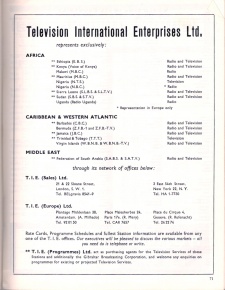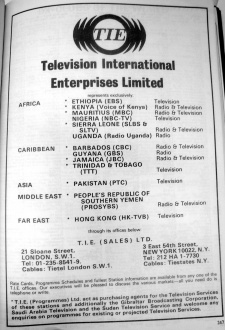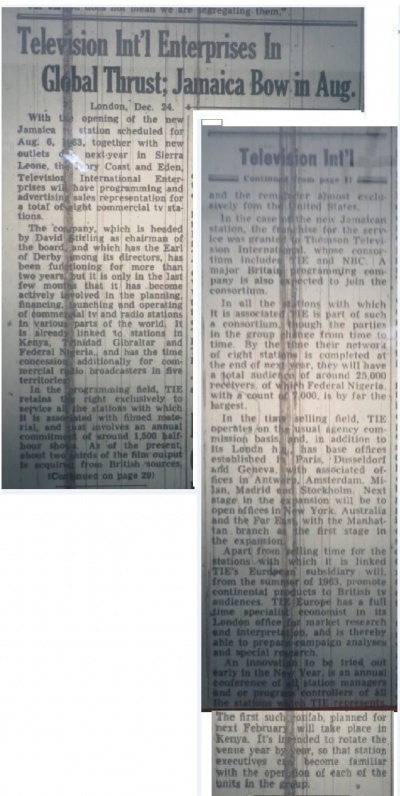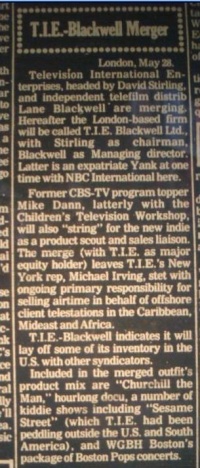TIE Ltd
TELEVISION INTERNATIONAL ENTERPRISES LTD (TIE Ltd)
London-based Television International Enterprises Limited (T.I.E. Ltd) (incorporated in June 1959), its sales subsidiaries Television International Enterprises (Programmes) Ltd / T.I.E. (Programmes) Ltd, Television International Enterprises (Sales) Ltd / T.I.E. (Sales) Ltd (incorporated in January 1962), and other associated companies, was a key player in the television industry in the early 1960s.
The company was created by David Stirling initially to aid third world countries in Africa and the Middle East to establish a television service by assisting with funding, providing equipment and technical assistance, usually by way of international consortia (sometimes referred to as "technical partners") that involved other major industry specialists, such as Thomson Television International in tandem with major US players such as Time-Life and US networks like NBC.
Once a station was up and running, TIE often continued to be involved by acting as a representative agency through which television programmes were supplied and advertising slots were sold.
It was reported in the 26 December 1962 edition of Variety magazine (see right) that by the end of 1963, only four years after it had been established, TIE Ltd would have representation for a total of eight commercial TV stations:
Added to that list is Mauritius, which was another TV station that TIE helped set up.
By the end of the decade, TIE was directly responsible for raising twelve independent TV stations around the world and supplying them with a number of programmes -- see list below. (One of TIE's major success stories was the setting up of TVB in Hong Kong in 1965, a rival to Radiodiffusion's RTV (the channel that broadcast Doctor Who).)
And to begin with, TIE had "the right exclusively to service all the stations with which it is associated with filmed material, and that involves an annual total of around 1,500 half-hour shows", of which two thirds were sourced from Britain (as noted in the 26 December 1962 edition of Variety).
But for how long that exclusivity lasted is not known. Certainly, after several years of operation, when the TV stations no longer needed Thomson's involvement, and their ability to buy programming could be handled internally, the need for a sales and purchasing middleman decreased.
(In the case of the BBC, it dealt directly through TIE rather than the stations in question. Did that arrangement change in later years once TIE's operations became less-specialised? Did they relinquish that exclusivity?)
And although "Television" was part of its name, it also had a number of radio stations as customers. (TIE Sales was the US, Caribbean and African distributor for Stanmark Productions Ltd, who attempted to launch a series of Doctor Who radio serials in the 1960s.)
TIE was a regular attendee at television and radio promotion events such as the annual Cannes Television Film Festival, MIP-TV, MIPCOM, and NATPE where sales and distribution deals were made.
Doctor Who was just one of hundreds of programmes for which TIE is known to have promoted and sold in the mid 1960s.
SALES CENTRES
In the early 1960s, TIE had a number of subsidiary companies with sales divisions around the world – such as TIE (Europe) Ltd, which had base offices in Paris, Dusseldorf, and Geneva, with associated offices in Antwerp, Amsterdam, Milan, Madrid and Stockholm. TIE (Sales) Ltd also handled the Middle East from an office in Beirut, Lebanon (which was vacated during the 1975 Lebanese civil war).
T.I.E. (Sales) Ltd was a joint-venture between TIE and US distributor Overseas Broadcast Services Ltd which operated from offices in New York City.
(Of note, by July 1965 (see below), the BBC had offered but failed to sell Doctor Who to the following countries: Italy, Sweden, United States, Netherlands, Switzerland, Lebanon, and Germany, all of which were -- coincidentally? -- countries where TIE had an associated office!)
In the late 1960s, TIE's representation was out of only two offices: London and New York. TIE itself was based at 21 Sloane Street, London, before relocating to 22 South Audley Street.
TIE (Sales) was the main representative for the radio and/or TV stations in the USA, the Caribbean and Africa, with countries such as Jamaica, Trinidad, Barbados, Dominican Republic, Gibraltar, Aden, Sierra Leone, Nigeria, Kenya, Ethiopia, Uganda and Mauritius on their books. The London-based parent company, TIE Ltd remained the US and foreign rep for stations in England and Europe only.
US and UK-based sellers looking at advertising their wares on overseas radio and television stations would approach the relevant TIE sales office, who would buy commercial airtime on the stations it acted for. And for those foreign stations that also produced their own radio and television programming, TIE also acted as the agent selling those productions to other overseas markets.
One of TIE's other chief functions was to act as a purchasing agent, specifically for those television broadcasters that had limited budgets and contacts or who were unable to attend the programme sales events themselves.
TIE (Programmes) Ltd was the subsidiary that specifically handled programme purchases and distribution, sometimes undertaking the audition process. As reported in Variety magazine of 26 February 1964 (see right), TIE purchased thousands of hours of programming a year from American and British sources, of which some 60% was from the US, and the other 40% from Britain.
TIE did not own or store film prints or tapes of radio plays – if it did so, it would have literally thousands of them to keep and maintain! – as it was simply a middle-man. After the ink had dried on the paperwork, the programme supplier took over, providing the film prints and often arranging and finalising any subsequent sales.
By 1971, at the time of the Sesame Street contract (see below) the London office had taken over the UK representation for some of the Caribbean and African stations, as well as new markets in Asia, while the US sales fell under the control of a new subsidiary called TIE States Ltd.
TIE AND DOCTOR WHO
At some point during late 1964 and early 1965, TIE (Programmes) approached the BBC for material that it could on-sell to its clients that operated a TV station that broadcast in English. Of the programmes purchased were the first five serials / 26 episodes of Doctor Who.
The only known mention of TIE in any surviving BBC documentation is in a BBC Enterprises memo dated 7 July 1965: "T.I.E." is recorded as having "bought prints for showing in Gibraltar, Aden, Trinidad, and Bermuda". The stories named were the first five only, up to and including The Keys of Marinus.
It's very important to note that this is merely the wording used by the person who compiled the list; a person who would have had absolutely no knowledge or idea of what TIE's internal processes and film-sharing procedures were, nor how and when they actually intended to circulate those films, or the order in which they would go to air. Plus, there was always the possibility that between the sale, when this memo was circulated and when the episodes finally went to air, those plans could easily change. (By the time that memo was written, Gibraltar had aired up to part two of Inside the Spaceship, and Aden had screened An Unearthly Child part one. The other two named countries didn't air the series until October and December respectively.)
The only solid reason why the BBC would need to know the precise order in which the countries were to air the series would be if the BBC themselves was supplying the prints to those countries directly.
That the countries are listed in the memo in the same order in which the series did end up going to air, could be entirely coincidental! Indeed, the order in which the first ten countries are recorded in that memo mostly mirrors the same order in which they appear in the Clearances paperwork. Did the writer of the memo simply consult the Clearances registers?
It does seem somewhat fortuitous and coincidental that TIE would have approached the BBC with four foreign stations already lined up. So, maybe TIE originally went to the BBC on behalf of just one of those four stations, but walked away with a deal that ultimately covered a further three stations for the same fixed price.
HOW MANY PRINTS?
What's not clear from the wording in this memo is whether there were four sets of the 26 episodes (i.e. 104 prints in total), or three sets to be shared between the four (i.e. 78 prints) or two sets (52 prints in total), or just one single set of the 26.
The price recorded for this "sale" to TIE was £1,587 2'11 (in pre-decimal currency) at £75 per print -- but whether you calculate using 26, 52, 78 or 104, it does not compute! (£75 x 26 = £1,950; £75 x 52 = £3,900; £75 x 78 = £5,850; £75 x 104 = £7,800.)
Was £1,587 2'11 perhaps a percentage 'deposit' payment, with the balance to be paid later?
An alternative is that TIE purchased just some of the episodes out of that first batch of 26; so, £1,587 2'11 divided by £75 works out (approximately) to cover 20 or 21 episodes. Did TIE buy only 21 episodes to be used as Audition prints, with a random set of episodes being sent to each country for evaluation?
A third possibility is that £1,587 2'11 was the licensing fee that TIE paid to the BBC for the prints (which works out to be roughly £14 per print, which is indeed close to the £12 cost of striking a 16mm print in the 60s), and the very profitable (!) £75 was what TIE was going to charge the countries (either individually or in a group deal), with some of that going to the BBC.
And the fourth likely answer (and the one that we prefer) is that the amount shown is merely a "sum paid so far". (In fact, the prices per print paid by some of the other countries don't quite add up either, which does support it only being the amount paid to date.)
In the case of these four countries and the fact that it was still a relatively new series being offered by the BBC, the "purchase" of these prints may have included the acquisition of Audition Prints only. In other words, TIE bought the 26 prints for the sole purpose of auditioning them to four of its customers, then once each broadcaster had agreed to take up the series, the BBC took over the sales and supplied the rest of the episodes directly via the bicycling system.
Of note, there is no overlap of the airdates in any of those four countries, which does strongly suggest there was only one print being moved around. Had TIE more than the one print, then there ought to be at least one overlap of dates between the countries. That there isn't is a significant factor.
If there was just the one set, the film prints were likely sent to Gibraltar first as it was the nearest in terms of distance from London, then to Aden, then over to the two Caribbean countries (as noted below, each country may have only received some of the 26 episodes, rather than all of them). All four took up the offer, with the BBC supplying the rest of the prints. And since the Audition prints had already been moved on to the next country of offer, the station probably received a fresh set of the same episodes they had just auditioned.
The very fact that TIE is mentioned only in passing in this memo and not in any other sales documentation (at least, not in any that still survives today) does suggest that its involvement with Doctor Who was perhaps limited only to that particular group of sales in 1965. The BBC certainly would have provided the rest of the prints, and liaised directly with the broadcasters for all subsequent purchases, effectively removing TIE from the equation since its role in the sales process had ended.
In conclusion, after weighing up the options, our instinct is that TIE supplied each of Gibraltar, Aden and Trinidad with its own set of prints, effectively placing them at the start of bicycling chains in three different continents. (The origin of the Bermuda prints is a bit hazy, since TIE had been replaced as purchasing agent in early 1966, Bermuda may have got its prints from Canada rather than TIE's station in Trinidad.)
SALES REGIONS
 Print ad for TIE Ltd; from WRTH 1966 |
 Print ad for TIE Ltd; from WRTH 1969 |
 Print ad for TIE Ltd; from WRTH 1972 |
Based on the available print ads from the World Radio TV Handbooks from 1964 to 1972 (three of which are illustrated above) TIE (Programmes) Ltd acted as television programme purchaser for the following countries and regions that aired Doctor Who:
(*Although strictly speaking it is part of Europe, its geographical position may have meant that Gibraltar fell under the category of "Africa")
- Barbados (until 1970 only)
- Bermuda (until Jan 1966 only) **
- Jamaica
- Trinidad & Tobago
- Abu Dhabi (after 1972)
- Federation of South Arabia (Aden)
- Saudi Arabia
TIE was a key member of the international consortia that built the TV stations in all the African and Caribbean countries listed above, with the exception of Gibraltar.
- NOTE: ** (Bermuda is not named as having TIE (Programmes) Ltd as a "purchasing agent" in any of the print ads for TIE after 1965; but the ad in the 1965 edition of the WRTH lists only Bermuda Radio, but not a TV station. ZFB-TV was established in August 1965 (after that edition of the WRTH was published) with the aid of the consortium that TIE was a member. But in early 1966, ZFB-TV became an affiliate of the US network ABC, who replaced TIE as it exclusive programme supplier. That sudden change of distributor would explain why Doctor Who did not air in Bermuda beyond the initial 26 purchased for them by TIE.)
Our attempts at tabulating some of the bicycling paths between countries within these regions can be seen on the Bicycling Chains page.
"ONE OF THESE THINGS IS NOT LIKE T.I.E. OTHER"
TIE's greatest achievement came in late 1970 / early 1971 when it was contracted by the Children's Television Workshop to sell Sesame Street to broadcasters throughout Africa, Europe and the Far East.
(It may be purely coincidental that the final round of sales of Doctor Who to broadcasters that were on TIE's books - such as Sierra Leone and Ethiopia - were in 1970. Did the acquisition of the CTW contract in early 1971 force the distributor to drop or at least minimise its association with the BBC in order to concentrate on promoting Kermit and co around the world, or – as noted above – had TIE's brief association with Doctor Who already ended in 1965?)
The fact that TIE successfully sold Sesame Street to a significant number of countries in Africa suggests that the distributor may have operated for a time a central distribution point – or "bicycling hub" – in Africa through which the films would be routed. Such a facility would therefore have to store multiple prints of hundreds of episodes of Sesame Street as well as any other programming it was also selling.
However, since TIE Sales had offices in both London and in New York (where the Children's Television Workshop was also based) from which the films would be struck, stored and despatched, and there were already very robust bicycling systems operating in West and East Africa for the movement and temporary storage of films, as far as Sesame Street was concerned, there was no need for a "hub" in Africa, the Middle East or Asia.
In other words, if such a facility existed, it would have been used for the distribution of Sesame Street, but extant documentation indicates that the bicycling system, in which the broadcasters act as "hubs", was used instead.
Distribution centres are discussed in more on the Bicycling Chains page.
THE FINAL DAYS OF T.I.E.
In May 1974, TIE Ltd planned to merge with another London-based international TV distributor, Lane Blackwell Limited; the joint-venture becoming TIE-Blackwell Ltd. But in February 1975, less than one year later, this co-venture came to an end. Lane Blackwell went back to distributing programmes on a solo basis. (Of note, there is no company called TIE-Blackwell Limited registered at the UK companies office. Was the name of the joint-venture changed to something else before being registered, or did the planned merger collapse before it was ever officially registered?)
TIE Ltd continued distributing for at least another decade but in a much-reduced capacity following a major restructure: for instance, TIE (Europe) Ltd was renamed TIE (Fiji) Ltd in December 1976.
TIE Ltd eventually ceased trading in the 1990s. (The company certainly reduced its operations following the death of its founding-director, Sir David Stirling in November 1990.)
TIE (Sales) Ltd was dissolved in June 1999. The parent company was kept under caretaker management in all but name only until it was officially dissolved in 2007.





